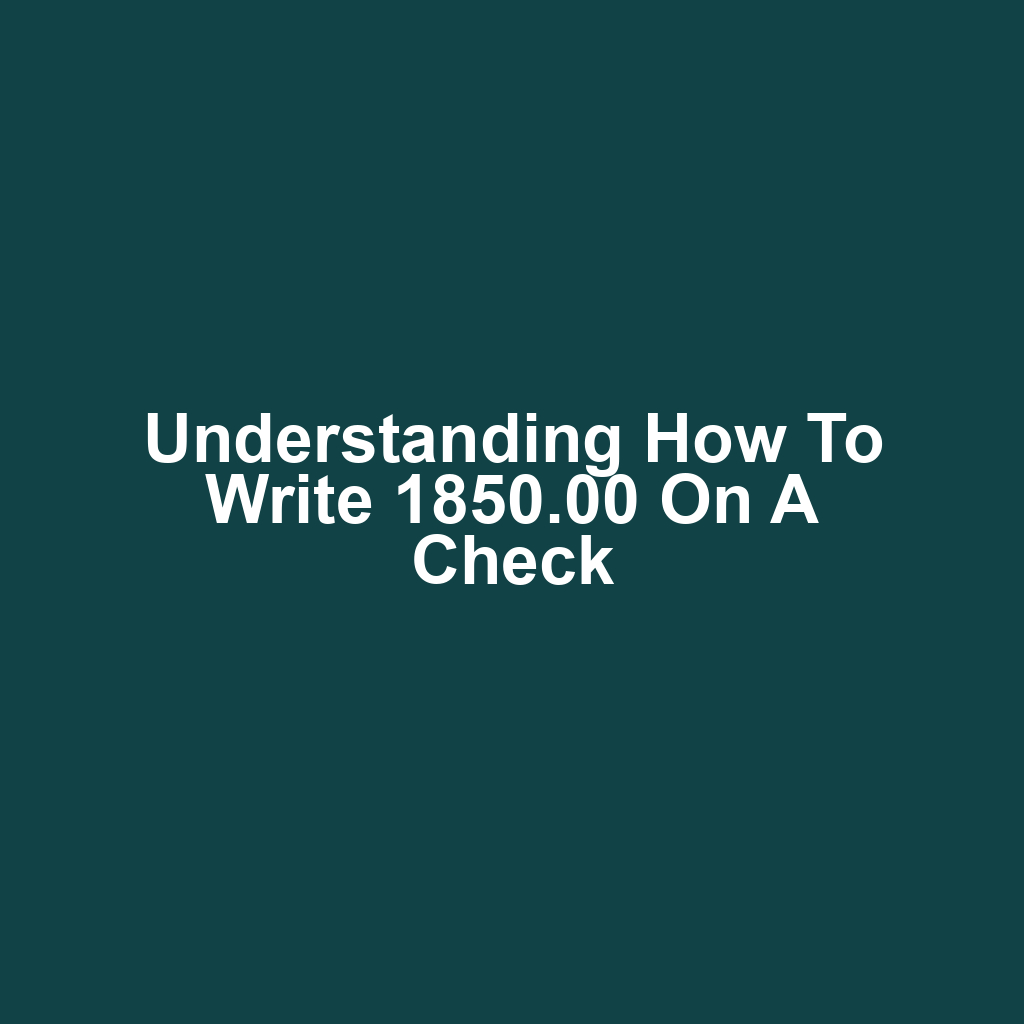When I first started writing checks, I found it a bit confusing, especially when it came to larger amounts. One question that often popped into my mind was how to write 1850.00 on a check without making any mistakes. I realized that there’s a specific format to follow, and getting it right is essential for clarity and accuracy. In this article, I’ll share the steps I learned to write checks properly, ensuring the amount is clear both numerically and in words. By the end, you’ll feel confident in your ability to tackle any check-writing task!
Choosing the Right Check Format
I often find that choosing the right check format makes a big difference in how clearly the amount is presented. When I write checks, I always make sure to use a clean and legible font. I prefer to write the amount in both numbers and words to avoid any confusion. It’s important to place the decimal point correctly to indicate cents. I usually write "One thousand eight hundred fifty and 00/100" on the line. In the box, I simply write "1850.00." I also make sure to leave enough space in the amount box. I avoid using any unnecessary symbols that could cause misunderstandings. This attention to detail helps ensure my checks are processed without issues.
Breaking Down the Amount
Breaking down the amount, I’ve got to write "one thousand eight hundred fifty and 00/100" on the check. I always start by writing the number in words to avoid any confusion. It helps to visualize the amount before putting it down. Then, I make sure to double-check that I’ve got the right figures. I don’t want to mess up such an important detail. After that, I also write "1850.00" in the box provided. This confirms the amount in numerical form. I usually take my time to ensure everything looks neat. Finally, I sign the check, knowing I’ve got it right.
Writing the Numeric Portion
Writing the numeric portion of the check, I’ve learned to clearly write "1850.00" without any confusion. I make sure the digits are distinct and legible. I always start with the number "1," ensuring it stands tall. Next, I follow it with "8," "5," and "0," keeping them evenly spaced. I remember to add the decimal point right after the "0." Then, I finish with two zeros for the cents. I often double-check my work to avoid any mistakes. I’ve found that using a darker pen helps with clarity. Clearly writing the numeric amount gives me confidence in my checks.
Writing the Written Amount
The written amount on my check should clearly state "One thousand eight hundred fifty and 00/100." I always make sure to write it legibly. It’s important that every word is clear to avoid any confusion. I prefer to use capital letters for the numbers and the word "and." I never forget to include the "and" before the cents. It helps to separate the dollar amount from the cents. I usually check my spelling to ensure there are no mistakes. I also make sure to draw a line after the written amount to prevent any alterations. Finally, I feel satisfied knowing I’ve completed the check correctly.
Adding the Memo Line
Adding a memo line helps me remember what the payment was for. I usually jot down a few words that describe the purpose. It keeps my records organized and clear. Sometimes, I also include the date of the service or purchase. When I look back at my checks, it’s easier to recall the details. I’ve found that it helps me avoid confusion later on. I appreciate having that little reminder right there on the check. It’s a small step that makes a big difference. Overall, I think it’s a smart practice.
Finalizing and Signing the Check
Now that I’ve added the memo line, it’s time to finalize and sign the check. I need to ensure everything is in order before I put my signature on it. Let’s look at the key points for completing the payee line and signing the check properly.
Completing the Payee Line
I’ve got to make sure I spell the payee’s name correctly to avoid any issues later. It’s crucial that I double-check the spelling before I write it down. If I get it wrong, it could cause delays or complications. Once I’m confident in the name, I’ll write it neatly in the payee line. Finally, I’ll sign the check with care to ensure it’s all set for processing.
Signing the Check Properly
Signing the check properly requires a steady hand and clear letters. I always take a moment to breathe before I sign, ensuring my signature is neat. It’s important that my name matches what’s on record to avoid any issues. I usually double-check the amount written in numbers to make sure it aligns with my signature. Once I’m satisfied, I’ll confidently put my pen down and hand over the check.
Conclusion
In wrapping up, I’ve realized that writing a check requires attention to detail and clarity. Making sure both the numerical and written amounts match is crucial to avoid any potential mix-ups. I’ve also learned the importance of neatness and legibility throughout the process. Taking a moment to double-check everything before signing can really save a lot of headaches later on. Overall, understanding these steps has made me feel more confident in handling financial transactions.
If you’re looking for natural remedies to enhance your well-being, I highly recommend visiting the page on the benefits of peppermint oil for dizziness relief. This informative resource provides valuable insights into how peppermint oil can help alleviate symptoms and improve your overall health. Check it out here: peppermint oil.
